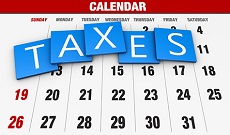How To Find Cost Basis Of Old Stock
Selling an investment typically has tax consequences. To figure out whether you lot demand to written report a gain—or can merits a loss—after you sell, you need to know the price ground for that investment.

You usually get toll-basis
data on the confirmation
statement that the banker
sends you subsequently you have
purchased a security.
For stocks or bonds, the cost basis is mostly the price yous paid to purchase the securities, including purchases fabricated by reinvestment of dividends or capital gains distributions, plus other costs such as the commission or other fees yous may accept paid to complete the transaction. You lot commonly become this information on the confirmation statement that the broker sends you later on yous take purchased a security.
You—the taxpayer—are responsible for reporting your price basis information accurately to the IRS. You do this in most cases by filling out Form 8949. (For revenue enhancement history junkies, this form replaced the Form 1040 Schedule D-1 in taxable yr 2011 for most cost-ground reporting.)
You lot're not totally on your own when it comes to computing toll basis. In 2008, Congress passed a constabulary that requires brokerage firms, common funds and others to give you a hand.
Brokerage Firm Responsibilities
In its Toll Basis Reporting FAQs, the IRS lays out what cost-basis reporting must be provided past brokerage firms and other financial institutions. Currently, brokerage firms must written report cost basis and the type of uppercase gain (short-term or long-term) on Form 1099-B (or a substitute statement) for the auction of the following types of securities:
- Shares of stock, including exchange-traded funds (ETFs) that are not treated as regulated investment companies (RICs) for taxation purposes, you acquired on or after Jan 1, 2011;
- Shares of stock in RICs and stocks acquired in connection with dividend reinvestment plans acquired on or later January one, 2012;
- Specific debt securities (for instance bonds with a fixed rate of interest and fixed maturity appointment), securities futures contracts, options, rights and warrants purchased or caused on or later January 1, 2014; and
- All other debt securities (for instance nil coupon bonds that convert into involvement paying bonds) purchased or acquired on or after Jan one, 2016 (this tax information will exist reportable on 1099-B forms filed in 2017).
Investors should receive a copy of whatsoever 1099-B or substitute statement from their brokerage firm by February fifteen. Review this information as shortly as you become it. Check that the amount of cost ground your broker reports to the IRS matches your ain records—and if the amounts differ, contact the broker immediately to discuss any differences y'all find.
Investors should be aware that there are situations in which a firm may non be required—or is merely unable—to provide a cost-basis for a sale. This could be the case if the securities you sold were purchased many years agone, or if yous transferred your holdings from ane securities firm to another prior to the new reporting requirements.
If you have questions well-nigh what sales are reportable by your brokerage business firm, yous shouldn't hesitate to contact your financial professional. Many firms as well have a section on their website explaining cost ground, and the specific toll-basis data they provide to their customers.
4 Tape-KeepingTips
While brokerages take price-basis reporting obligations, it's yet important to keep skillful records of your transactions. Follow these tips:
- Concord on to trade confirmations showing how much you lot paid for specific shares or go along rails of that data on your own records at dwelling.
- Keep rails of stock dividends or non-dividend distributions you receive considering they may affect the toll basis of your shares.
- If you purchased stock of a company at different times and prices, and can adequately place the shares you sold, their basis is the cost for those specific shares (the IRS calls this "specific share identification"). If y'all cannot decide exactly which shares you are selling, tax rules generally require you to calculate a gain or loss as if y'all are selling the earliest acquired shares (sometimes referred to equally the "commencement in, first out" method).
- If you received the securities every bit a gift or through an inheritance, you may have to notice the off-white market value when information technology was given to you lot or the previous owner'due south adapted basis.
IRS Publication 550 offers detailed guidance on how to calculate cost ground under unlike circumstances. Information technology's also a audio practice to consult with a tax professional when computing and reporting a gain or loss.
The bottom line is that the IRS expects you to continue and maintain records that identify the price basis of your securities. If y'all do not take adequate records, you may have to rely on the cost basis that your broker reports—or you lot may be required to treat the cost basis as zero. For this reason, you may desire to cheque whether you have price basis information for any securities you want to sell earlier you do then.
Subscribe to FINRA's Investor News newsletter for more than information nearly saving and investing.
How To Find Cost Basis Of Old Stock,
Source: https://www.finra.org/investors/insights/cost-basis-and-your-taxes
Posted by: sandbergcasonctin.blogspot.com


0 Response to "How To Find Cost Basis Of Old Stock"
Post a Comment